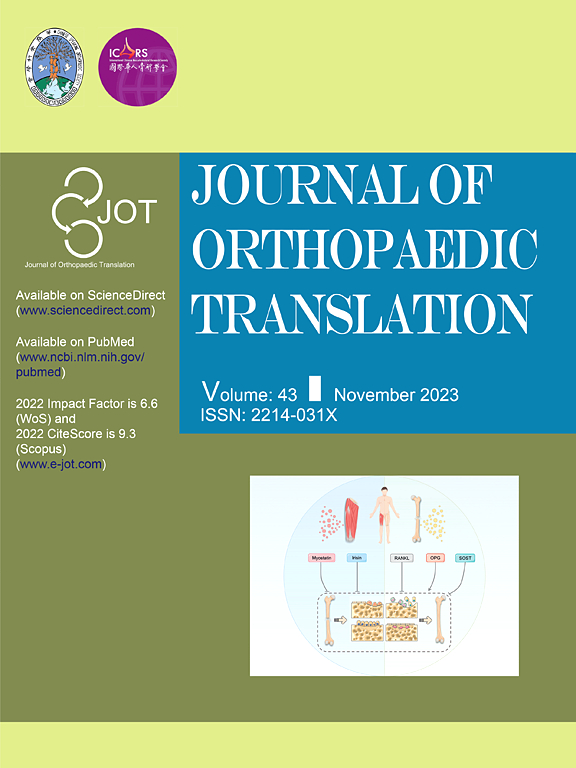Role of YAP/TAZ in bone diseases: A transductor from mechanics to biology
IF 5.9
1区 医学
Q1 ORTHOPEDICS
引用次数: 0
Abstract
Wolff's Law and the Mechanostat Theory elucidate how bone tissues detect and convert mechanical stimuli into biological signals, crucial for maintaining bone equilibrium. Abnormal mechanics can lead to diseases such as osteoporosis, osteoarthritis, and nonunion fractures. However, the detailed molecular mechanisms by which mechanical cues are transformed into biological responses in bone remain underexplored. Yes-associated protein (YAP) and transcriptional coactivator with PDZ-binding motif (TAZ), key regulators of bone homeostasis, are instrumental in this process. Emerging research highlights bone cells' ability to sense various mechanical stimuli and relay these signals intracellularly. YAP/TAZ are central in receiving these mechanical cues and converting them into signals that influence bone cell behavior. Abnormal YAP/TAZ activity is linked to several bone pathologies, positioning these proteins as promising targets for new treatments. Thus, this review aims to provide an in-depth examination of YAP/TAZ's critical role in the interpretation of mechanical stimuli to biological signals, with a special emphasis on their involvement in bone cell mechanosensing, mechanotransduction, and mechanoresponse.
The translational potential of this article: Clinically, appropriate stress stimulation promotes fracture healing, while bed rest can lead to disuse osteoporosis and excessive stress can cause osteoarthritis or bone spurs. Recent advancements in the understanding of YAP/TAZ-mediated mechanobiological signal transduction in bone diseases have been significant, yet many aspects remain unknown. This systematic review summarizes current research progress, identifies unaddressed areas, and highlights potential future research directions. Advancements in this field facilitate a deeper understanding of the molecular mechanisms underlying bone mechanics regulation and underscore the potential of YAP/TAZ as therapeutic targets for bone diseases such as fractures, osteoporosis, and osteoarthritis.

YAP/TAZ在骨病中的作用:一个从力学到生物学的传感器。
沃尔夫定律和机械稳态理论阐明了骨组织如何检测并将机械刺激转化为生物信号,这对维持骨骼平衡至关重要。力学异常可导致骨质疏松、骨关节炎和骨不连骨折等疾病。然而,骨骼中机械信号转化为生物反应的详细分子机制仍未得到充分研究。yes相关蛋白(YAP)和带pdz结合基序的转录共激活因子(TAZ)是骨稳态的关键调节因子,在这一过程中起着重要作用。新兴的研究强调了骨细胞感知各种机械刺激并在细胞内传递这些信号的能力。YAP/TAZ是接收这些机械信号并将其转化为影响骨细胞行为的信号的核心。异常的YAP/TAZ活性与几种骨病理有关,将这些蛋白定位为新治疗的有希望的靶点。因此,本文旨在深入研究YAP/TAZ在解释生物信号的机械刺激中的关键作用,并特别强调它们在骨细胞机械传感、机械转导和机械反应中的作用。本文的翻译潜力:临床上,适当的应激刺激促进骨折愈合,而卧床休息可导致废用性骨质疏松症,过度应激可导致骨关节炎或骨刺。最近对骨疾病中YAP/ taz介导的机械生物学信号转导的理解取得了重大进展,但许多方面仍不清楚。本系统综述总结了当前的研究进展,指出了尚未解决的领域,并强调了潜在的未来研究方向。这一领域的进展有助于更深入地了解骨力学调控的分子机制,并强调了YAP/TAZ作为骨折、骨质疏松症和骨关节炎等骨病治疗靶点的潜力。
本文章由计算机程序翻译,如有差异,请以英文原文为准。
求助全文
约1分钟内获得全文
求助全文
来源期刊

Journal of Orthopaedic Translation
Medicine-Orthopedics and Sports Medicine
CiteScore
11.80
自引率
13.60%
发文量
91
审稿时长
29 days
期刊介绍:
The Journal of Orthopaedic Translation (JOT) is the official peer-reviewed, open access journal of the Chinese Speaking Orthopaedic Society (CSOS) and the International Chinese Musculoskeletal Research Society (ICMRS). It is published quarterly, in January, April, July and October, by Elsevier.
 求助内容:
求助内容: 应助结果提醒方式:
应助结果提醒方式:


